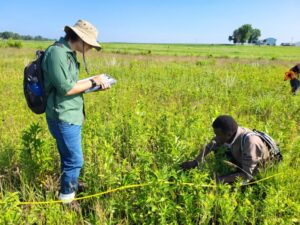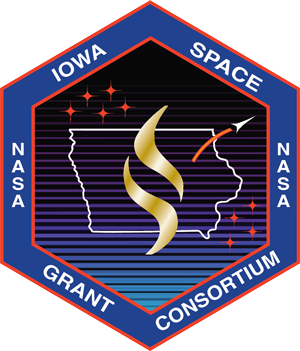 The Pollinator Habitat Enhancement Conservation Reserve Program (CP-42) allows farmers to turn their land, once used for agriculture, into restored prairie to provide floral sources and habitat for wild pollinators. In order for these sites to be fully effective, they must be accessible to native bees and other pollinator species. Previous research was conducted in 16 CP-42 sites in Northeast Iowa to examine the wild bee community composition and genetic diversity. Through this NASA research project, we will examine 16 CP-42 sites and understand the habitat connectivity between these restored habitats and other natural habitats in the landscape, and determine how native bee species travel between habitats to colonize the restored CP-42 sites. These 16 sites were surveyed between 2018 and 2023 to monitor the vegetation and the native bee communities within the area. Aerial images and roadside planting data will be georeferenced using ArcGIS software in order to delineate and quantify potential pollinator habitats surrounding these CP-42 sites. Paired with the collected bee data, we will associate the habitat connectivity among CRP sites and natural habitats to the bee diversity and density data, in order to understand the movement of these native bee species, and how these pathways are being used to establish new bee communities in these restored sites. This data will also help us to examine the degree of habitat fragmentation in the landscape and the effect that it may have on the native bee communities.
The Pollinator Habitat Enhancement Conservation Reserve Program (CP-42) allows farmers to turn their land, once used for agriculture, into restored prairie to provide floral sources and habitat for wild pollinators. In order for these sites to be fully effective, they must be accessible to native bees and other pollinator species. Previous research was conducted in 16 CP-42 sites in Northeast Iowa to examine the wild bee community composition and genetic diversity. Through this NASA research project, we will examine 16 CP-42 sites and understand the habitat connectivity between these restored habitats and other natural habitats in the landscape, and determine how native bee species travel between habitats to colonize the restored CP-42 sites. These 16 sites were surveyed between 2018 and 2023 to monitor the vegetation and the native bee communities within the area. Aerial images and roadside planting data will be georeferenced using ArcGIS software in order to delineate and quantify potential pollinator habitats surrounding these CP-42 sites. Paired with the collected bee data, we will associate the habitat connectivity among CRP sites and natural habitats to the bee diversity and density data, in order to understand the movement of these native bee species, and how these pathways are being used to establish new bee communities in these restored sites. This data will also help us to examine the degree of habitat fragmentation in the landscape and the effect that it may have on the native bee communities.
Ethan Dickey – University of Northern Iowa
Student: Ethan Dickey, Undergraduate Student in Biology, University of Northern Iowa
Research Mentor: Dr. Ai Wen

Using GIS to evaluate the habitat isolation among pollinator Conservation Research Program habitat
2023-2024, Undergraduate
